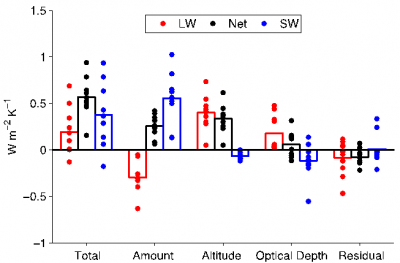Illuminating the Processes Contributing to Cloud Feedback
The amount, altitude, and reflectivity of clouds are all likely to change as the planet warms due to greenhouse gases, and all of these changes have implications for the planet’s energy budget. In the companion study to that describing the cloud radiative kernel technique for computing cloud feedbacks DOE- funded researchers have for the first time systematically quantified cloud feedbacks arising from these three changes across an ensemble of climate models. Such a breakdown is appealing in that it helps to identify the processes for which models agree and disagree, and where efforts should be placed in attempting to narrow the spread in cloud feedbacks among models.
The authors made use of cloud radiative kernels developed in Part I of this study to quantify the contribution to cloud feedback from changes in cloud amount, altitude, and reflectivity as the planet warms due to a doubling of carbon dioxide. For each feedback, the other cloud properties were held fixed so as to isolate the individual processes that alter clouds, and therefore alter the Earth's energy budget as the planet warms. Robust features of climate model predictions are that overall there will be fewer, higher, and brighter clouds in a warmer climate, though these changes have a rich spatial structure. For example, the cloud cover decreases almost everywhere equatorward of about 50 degrees latitude and increases elsewhere, and cloud reflectivity increases primarily at high latitudes. In this study, the impact of all of these changes on the radiation budget of the planet are quantified across models for the first time.
The authors found that both increasing cloud top altitude and reduction in cloud amount cause the global mean cloud feedback to be robustly positive across models. In addition, they found that model-to-model differences in the cloud altitude feedback are actually larger than those of the cloud amount feedback. Together with results from Part I of this study, these results provide a caution against solely attributing the large uncertainty in cloud feedback to low clouds, which is the prevailing viewpoint within the cloud feedback community. Finally, the authors demonstrated that the large negative cloud feedback at high latitudes results from large, robust increases in cloud optical depth (due to substantial increases in cloud liquid water content) rather than from increases in total cloud amount. This is surprising, considering that this feature is commonly attributed to increased cloud amount associated with the poleward shift of the midlatitude storm track as the planet warms. However, it is consistent with a number of observational, theoretical, and modeling studies which suggest that cold clouds should become optically thicker in a warmer climate.
The authors partition cloud feedbacks in an ensemble of climate models into components arising from changes in total cloud amount, altitude, and reflectivity. This is the first study to systematically quantify these components across models, and provides substantial insight into the aspects of cloud feedback on which models agree and disagree. All models exhibit positive cloud amount and altitude feedbacks arising from the robust reduction in cloud amount and increase in cloud top altitude. Furthermore, the negative cloud feedback at high latitudes that is common to all models is clearly shown to be due to increases in cloud reflectivity associated with increased cloud water content, not increases in cloud amount as is commonly assumed.
We acknowledge the international modeling groups, the Program for Climate Model Diagnosis and Intercomparison (PCMDI), and the WCRP’s Working Group on Coupled Modelling (WGCM) for their roles in making available the WCRP CFMIP multimodel dataset. Support of this dataset is provided by the Office of Science, U.S. Department of Energy. We thank Karen Shell and one anonymous reviewer for their detailed critiques of this manuscript; Brian Soden for providing radiative kernels; Rick Hemler for providing additional GFDL MLM2.1 model output; Rob Wood, Chris Bretherton, and Robert Pincus for the useful discussion and their suggestions for improvement; and Marc Michelsen for computer support. This research was supported by the Regional and Global Climate Modeling Program of the Office of Science at the U. S. Department of Energy and by NASA Grant NNX09AH73G at the University of Washington. This work was performed under the auspices of the U.S. Department of Energy by Lawrence Livermore National Laboratory under Contract DE-AC52-07NA27344.

